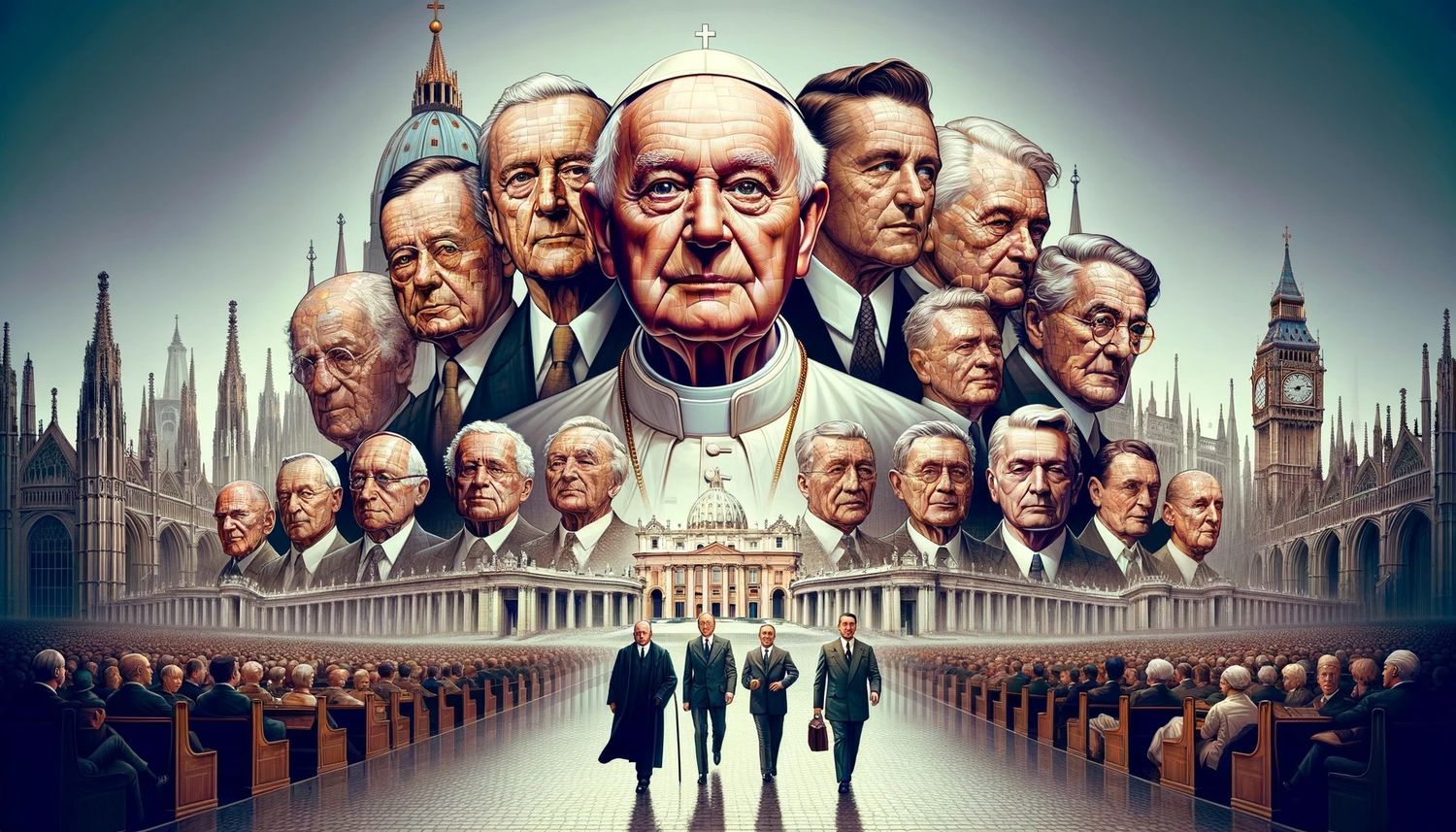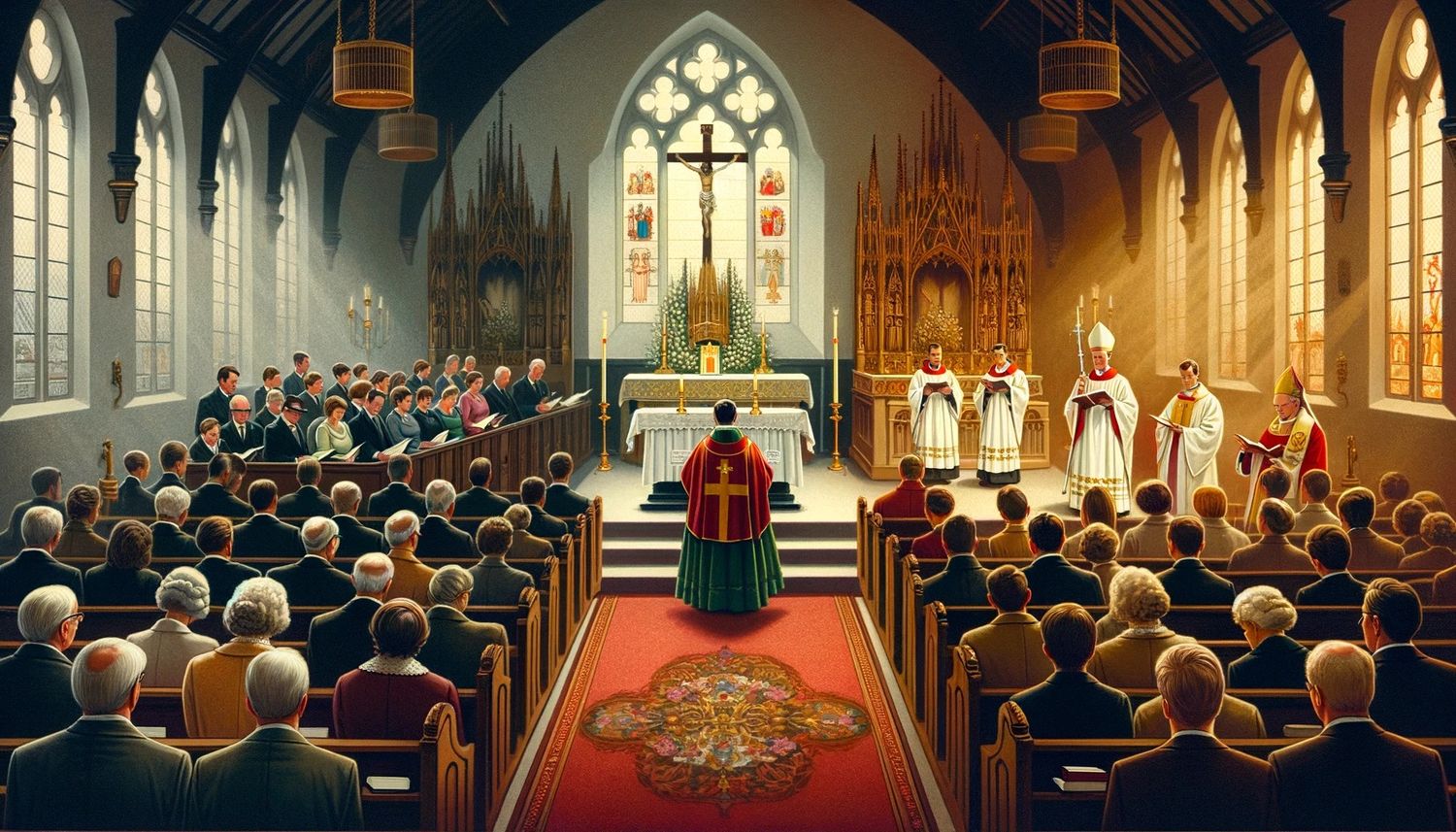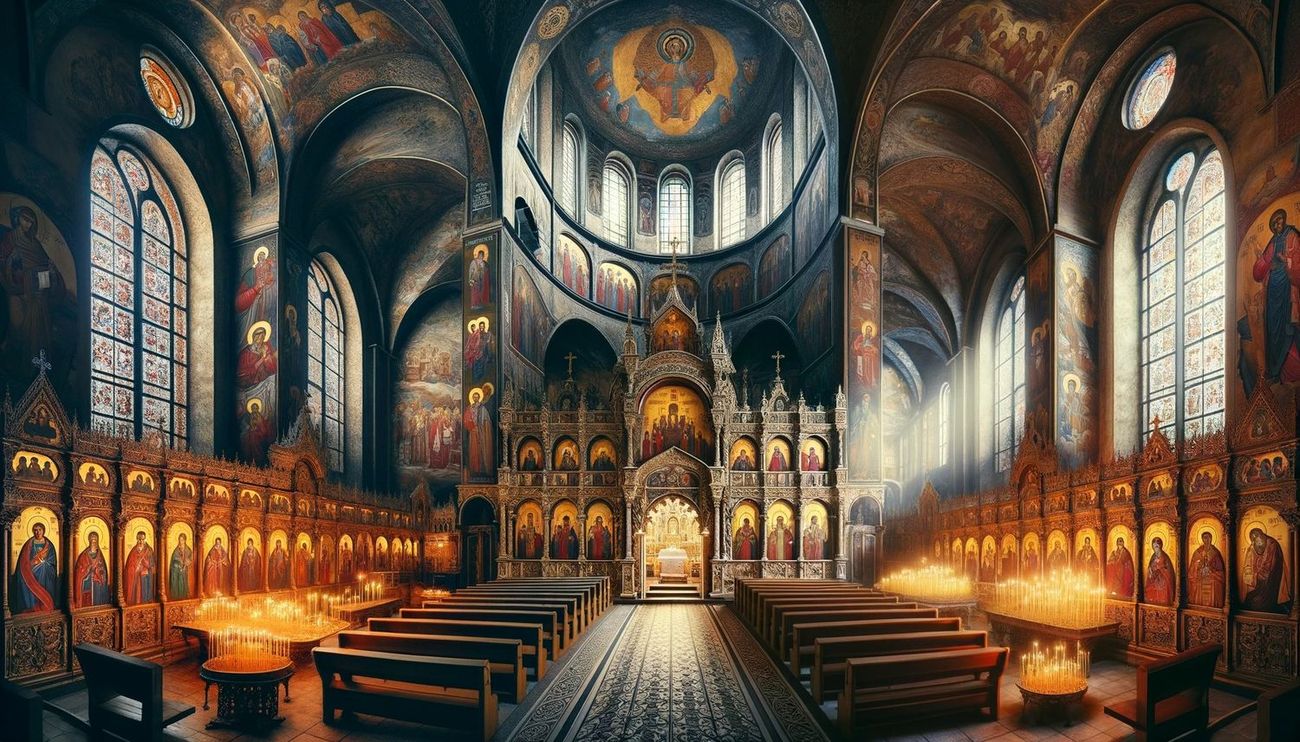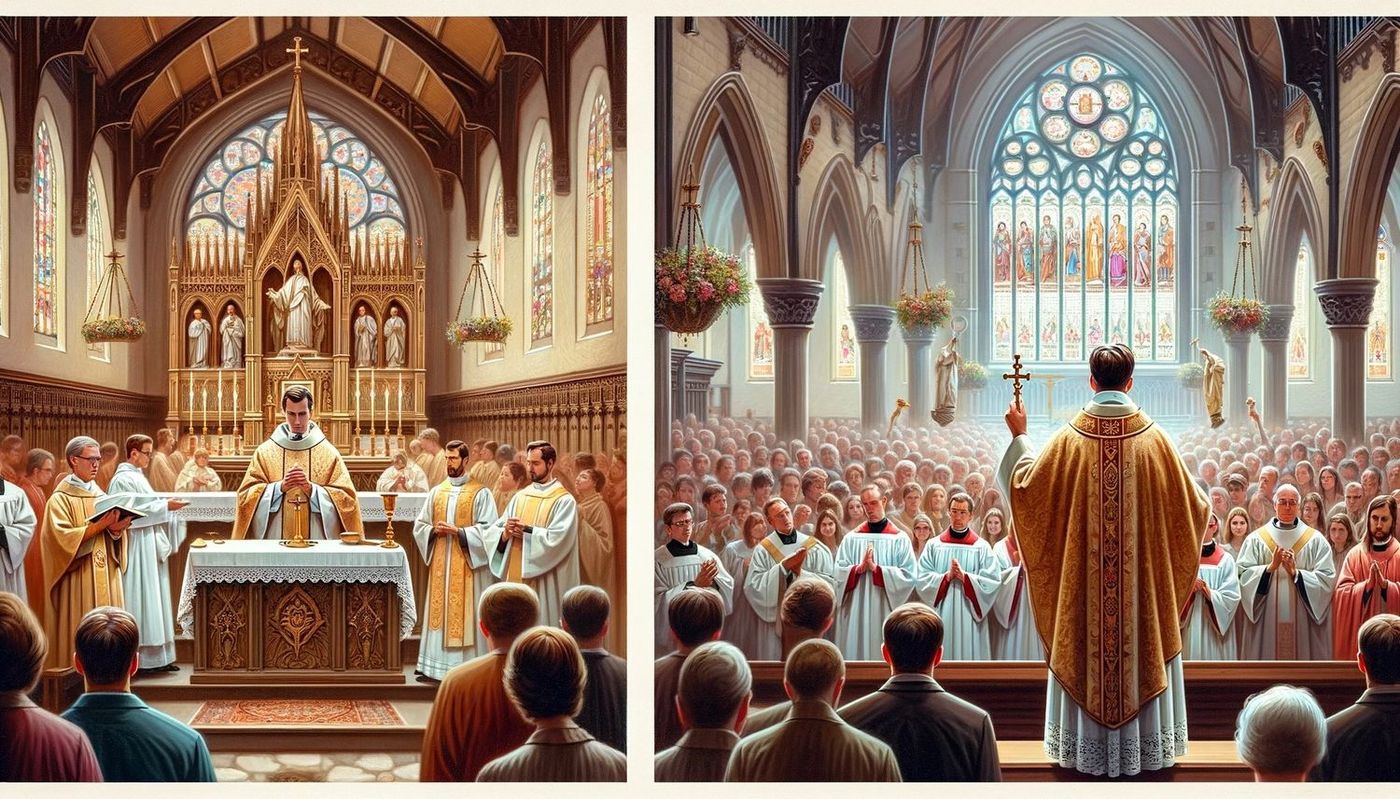Home>Theology and Spirituality>How Is Judaism Different From Catholicism


Theology and Spirituality
How Is Judaism Different From Catholicism
Published: February 15, 2024
Jason DeRose, Managing Editor at Christian.net, uses his expertise in religion and journalism to deepen understanding of faith's societal impacts. His editorial leadership, coupled with a strong academic background, enriches the platform’s diverse content, earning him recognition in both journalism and religious circles.
Discover the key differences between Judaism and Catholicism in terms of theology and spirituality. Explore the unique beliefs and practices that set these two religions apart.
(Many of the links in this article redirect to a specific reviewed product. Your purchase of these products through affiliate links helps to generate commission for Christian.net, at no extra cost. Learn more)
Table of Contents
Introduction
Judaism and Catholicism are two prominent religious traditions that have significantly shaped human history and culture. While both are rooted in monotheistic beliefs, they differ in various aspects, including their sacred texts, religious practices, and views on salvation. Understanding the distinctions between Judaism and Catholicism provides valuable insights into the diversity of religious thought and practice.
These two faiths have distinct historical and cultural backgrounds. Judaism, one of the oldest monotheistic religions, traces its origins to the covenant between God and the patriarch Abraham. Its rich history encompasses the exodus from Egypt, the giving of the Torah at Mount Sinai, and the establishment of the kingdom of Israel. In contrast, Catholicism emerged from the teachings of Jesus Christ and the early Christian community, evolving into a global religious institution with a complex hierarchy and diverse traditions.
Exploring the differences between Judaism and Catholicism offers a deeper understanding of the complexities and nuances within the broader tapestry of religious beliefs and practices. This exploration can foster greater appreciation for the diversity of human spirituality and the ways in which individuals and communities seek meaning, connection, and transcendence through their religious traditions.
Read more: How Are Calvinism And Catholicism Different
Beliefs and Practices
Judaism
- Monotheism: Judaism is founded on the belief in one God, who is transcendent, omnipotent, and the creator of the universe. This central tenet is encapsulated in the Shema, a fundamental declaration of faith recited by devout Jews.
- Covenant: The concept of a covenant between God and the Jewish people is pivotal in Judaism. This covenant, as established with Abraham and later reaffirmed at Mount Sinai, forms the basis of the Jewish faith and shapes the relationship between God and the Jewish community.
- Ethical Living: Judaism places a strong emphasis on ethical living and moral conduct. The ethical teachings found in the Torah and other sacred texts guide adherents in their interactions with others and their responsibilities to the wider community.
- Observance of Mitzvot: Observance of mitzvot, or commandments, is central to Jewish religious practice. These commandments cover a wide range of aspects, including prayer, dietary laws, ethical behavior, and rituals such as observing Shabbat and celebrating festivals.
Catholicism
- Trinitarian Belief: Catholicism professes belief in the Holy Trinity, comprising the Father, Son, and Holy Spirit. This foundational doctrine underscores the threefold nature of God and is central to Catholic theology and worship.
- Sacraments: The Catholic Church places great importance on the seven sacraments, which are considered essential channels of divine grace. These sacraments include baptism, confirmation, the Eucharist, reconciliation, anointing of the sick, holy orders, and matrimony.
- Papal Authority: Catholicism is characterized by a hierarchical structure with the Pope as the spiritual leader and head of the Church. The Pope is regarded as the successor of St. Peter and holds the authority to make doctrinal and disciplinary decisions.
- Devotion to Mary and the Saints: Catholic devotion extends to Mary, the mother of Jesus, and various saints. This veneration includes prayers, devotional practices, and the belief in the intercession of saints on behalf of the faithful.
Distinctions
The differences in beliefs and practices between Judaism and Catholicism reflect their unique theological perspectives and historical developments. While Judaism emphasizes the oneness of God, the covenantal relationship with the Jewish people, and the observance of mitzvot, Catholicism centers on the Trinitarian belief, sacramental life, papal authority, and devotion to Mary and the saints. These distinctions contribute to the rich tapestry of religious diversity and highlight the multifaceted ways in which individuals and communities express their faith and spirituality.
Sacred Texts
Judaism
The sacred texts of Judaism are foundational to the faith and serve as a source of divine revelation, ethical guidance, and historical documentation. The Torah, which consists of the first five books of the Hebrew Bible—Genesis, Exodus, Leviticus, Numbers, and Deuteronomy—is revered as the central and most sacred scripture in Judaism. It encapsulates the narrative of creation, the patriarchs and matriarchs, the exodus from Egypt, and the giving of the divine law at Mount Sinai. The Torah is handwritten on a parchment scroll and is meticulously preserved and revered within Jewish communities.
In addition to the Torah, Judaism recognizes the significance of the Tanakh, which encompasses the Torah, the Nevi'im (Prophets), and the Ketuvim (Writings). These texts collectively provide a comprehensive understanding of Jewish history, theology, and moral teachings. The Talmud, a central text of Rabbinic Judaism, contains a compilation of discussions, interpretations, and commentaries on Jewish law, ethics, customs, and folklore. It serves as a guide for religious practice and ethical conduct within Jewish communities.
Catholicism
Catholicism draws its sacred texts from the Bible, which includes the Old Testament and the New Testament. The Old Testament, shared with Judaism, comprises the foundational scriptures of ancient Israel and encompasses a rich tapestry of narratives, laws, prophecies, and wisdom literature. The New Testament, centered on the life, teachings, death, and resurrection of Jesus Christ, forms the core of Christian belief and practice.
Within Catholicism, the Bible is revered as the inspired word of God and is considered authoritative in matters of faith and morality. The Church also recognizes the significance of sacred tradition, which encompasses the teachings, rituals, and doctrinal developments passed down through the centuries. The Magisterium, the teaching authority of the Church, plays a vital role in interpreting and safeguarding the integrity of sacred scripture and tradition.
Significance
The sacred texts of Judaism and Catholicism serve as pillars of faith, providing spiritual nourishment, moral guidance, and a sense of continuity with the religious heritage of their respective communities. While Judaism places central emphasis on the Torah and the Talmud as sources of divine revelation and ethical instruction, Catholicism reveres the Bible and sacred tradition as essential components of its theological framework. These sacred texts not only shape the religious identity of adherents but also foster a deep connection to the transcendent and the communal wisdom of their faith traditions.
Read more: How Is Methodism Different From Catholicism
Leadership and Hierarchy
Judaism
In Judaism, the leadership and hierarchy are structured around the roles of rabbis, cantors, and communal leaders within individual congregations. The rabbi, often regarded as the spiritual leader of a Jewish community, fulfills various responsibilities, including teaching, providing pastoral care, and officiating at lifecycle events such as weddings and funerals. Rabbis undergo extensive training in Jewish law, theology, and tradition, and their knowledge and guidance are integral to the religious life of their congregants.
Additionally, cantors play a vital role in leading congregational worship through the recitation of prayers and the chanting of liturgical music. Their melodic renditions elevate the spiritual atmosphere of services and evoke a sense of reverence and devotion among worshippers. Communal leaders, including synagogue board members and volunteers, contribute to the organizational and administrative aspects of the congregation, ensuring the smooth functioning of religious and communal activities.
The hierarchical structure within Judaism also encompasses the concept of a minyan, a quorum of ten adult Jews required for certain communal prayers and religious rituals. This communal gathering reflects the interconnectedness and shared responsibility within Jewish communities, emphasizing the significance of collective participation in religious observance and communal life.
Catholicism
Catholicism is characterized by a hierarchical structure that is centered on the Pope, bishops, priests, and deacons. The Pope, as the Bishop of Rome and the spiritual leader of the worldwide Catholic Church, holds a position of primacy and authority, serving as the successor of St. Peter and the Vicar of Christ on Earth. The College of Bishops, in communion with the Pope, shares in the governance and teaching ministry of the Church, ensuring doctrinal unity and pastoral guidance.
Bishops, appointed to oversee dioceses or regions, exercise authority over the priests and deacons within their jurisdictions, providing spiritual leadership, pastoral care, and oversight of religious practices. Priests, ordained to administer the sacraments and lead congregations, serve as spiritual guides and shepherds, offering counsel, celebrating Mass, and administering the sacraments to the faithful. Deacons, ordained ministers who assist priests in various liturgical and charitable ministries, contribute to the pastoral outreach and service within the Church and the wider community.
The hierarchical structure of Catholicism reflects the principles of apostolic succession, wherein authority and spiritual lineage are traced back to the apostles and ultimately to Jesus Christ. This hierarchical framework ensures the continuity of teaching, worship, and pastoral care within the Catholic tradition, fostering unity and coherence across diverse cultural and geographical contexts.
Distinctions
The leadership and hierarchy in Judaism and Catholicism embody distinct structures and roles that reflect the unique theological and historical developments of each tradition. While Judaism emphasizes the spiritual leadership of rabbis, cantors, and communal leaders within individual congregations, Catholicism is characterized by a centralized hierarchical structure with the Pope, bishops, priests, and deacons overseeing the spiritual and administrative facets of the Church. These distinct models of leadership and hierarchy contribute to the diverse expressions of religious authority and communal organization within Judaism and Catholicism, shaping the religious experiences and communal dynamics of their respective adherents.
Worship and Rituals
Judaism
Worship and rituals hold profound significance in Judaism, serving as integral expressions of faith, communal identity, and spiritual connection to the divine. Central to Jewish worship is the synagogue, a place of assembly and prayer where congregants gather to engage in communal worship, study, and celebration. The synagogue, also known as the shul, serves as a focal point for religious observance and communal life, fostering a sense of unity and shared devotion among the Jewish community.
The cornerstone of Jewish worship is the Shabbat, the weekly day of rest and spiritual rejuvenation that begins at sundown on Friday and concludes at nightfall on Saturday. Observing the Shabbat involves a rich tapestry of rituals, including the lighting of candles, recitation of blessings, partaking in festive meals, and refraining from work and certain activities. The synagogue becomes a hub of spiritual activity during the Shabbat, with congregants coming together for prayer services, Torah readings, and communal gatherings that evoke a sense of holiness and joy.
Another significant aspect of Jewish worship is the observance of festivals and holy days, such as Rosh Hashanah, Yom Kippur, Sukkot, Passover, and Shavuot. These occasions are marked by special liturgical readings, prayers, and rituals that commemorate historical events, express gratitude for divine blessings, and reaffirm the covenantal relationship between God and the Jewish people. The festive and solemn observances during these occasions create a rhythm of spiritual engagement and communal solidarity within Jewish communities.
Rituals also play a central role in Jewish lifecycle events, including circumcision, bar and bat mitzvahs, weddings, and funerals. These rites of passage are imbued with profound religious and communal significance, symbolizing the continuity of Jewish tradition, the transmission of ethical values, and the interconnectedness of individuals within the broader Jewish community.
Catholicism
In Catholicism, worship and rituals form the heart of religious practice, providing avenues for spiritual communion, sacramental grace, and communal devotion. The focal point of Catholic worship is the Mass, a sacred liturgical celebration that commemorates the Last Supper of Jesus Christ and the offering of his body and blood for the salvation of humanity. The Mass encompasses prayers, readings from the Bible, the consecration of bread and wine, and the reception of the Eucharist, fostering a profound encounter with the divine presence.
Catholic worship also encompasses the Liturgy of the Hours, a set of daily prayers and psalms that sanctify the various hours of the day, offering a rhythm of spiritual reflection and praise. The sacraments, including baptism, confirmation, reconciliation, anointing of the sick, holy orders, and matrimony, are central to Catholic rituals, serving as visible signs of God's grace and presence in the lives of believers.
The liturgical calendar of Catholicism features a rich tapestry of feasts, solemnities, and seasons, such as Advent, Christmas, Lent, Easter, and Pentecost, each marked by distinctive prayers, rituals, and devotional practices. These liturgical observances provide a framework for spiritual growth, communal worship, and the commemoration of key events in the life of Jesus Christ and the history of salvation.
Rituals also play a significant role in Catholic sacramentals, including blessings, processions, pilgrimages, and devotions to saints and holy relics. These practices serve as tangible expressions of faith, invoking divine blessings, protection, and intercession within the lives of the faithful.
Distinctions
The worship and rituals of Judaism and Catholicism reflect the unique theological emphases and historical developments of each tradition. While Judaism centers its worship around the synagogue, the observance of the Shabbat, festivals, and lifecycle events, Catholicism places emphasis on the Mass, the sacraments, the Liturgy of the Hours, and the liturgical calendar. These distinct expressions of worship and rituals not only shape the religious experiences of adherents but also foster a sense of communal identity, spiritual nourishment, and connection to the divine within Jewish and Catholic communities.
Read more: How Does Lutheran Differ From Catholicism
Views on Salvation
Judaism
In Judaism, the concept of salvation is deeply intertwined with the covenantal relationship between God and the Jewish people. Salvation, often understood in the context of national and communal redemption, is intricately linked to the fulfillment of divine promises and the restoration of harmony and justice in the world. The Hebrew Bible, particularly the prophetic writings, envisions a future era of peace, righteousness, and universal recognition of God's sovereignty, often referred to as the Messianic Age.
The notion of personal salvation in Judaism is multifaceted, encompassing the ethical living, adherence to mitzvot (commandments), and the pursuit of tikkun olam, the repair of the world through acts of justice, compassion, and righteousness. While the emphasis is on righteous conduct and moral responsibility, Judaism also acknowledges the role of divine mercy and forgiveness in the process of individual and collective redemption.
The concept of Olam Ha-Ba, the World to Come, represents the eschatological hope for a future state of spiritual perfection and closeness to God. This vision of salvation underscores the enduring significance of ethical living, repentance, and the enduring legacy of the Jewish people as bearers of God's covenant and moral teachings.
Catholicism
In Catholic theology, salvation is intricately tied to the redemptive work of Jesus Christ, who is regarded as the savior and mediator between humanity and God. The foundational belief in the incarnation, crucifixion, and resurrection of Jesus forms the cornerstone of Catholic views on salvation, emphasizing the transformative power of God's grace and the invitation to enter into a loving relationship with the divine.
Catholicism articulates the concept of salvation as a process of justification, sanctification, and glorification, wherein believers are justified through faith, sanctified through the indwelling of the Holy Spirit, and ultimately glorified in the eternal presence of God. The sacraments, particularly baptism and the Eucharist, are regarded as essential means through which believers receive and participate in the salvific grace of Christ.
The Catholic understanding of salvation encompasses the notions of divine mercy, repentance, and the moral agency of individuals. The Church's teachings on moral living, the practice of virtues, and the cultivation of a life of prayer and charity are integral to the journey of salvation, emphasizing the transformative power of God's love and the call to participate in the divine mission of reconciliation and renewal.
The Catholic vision of salvation culminates in the hope for eternal life in communion with God, the communion of saints, and the fulfillment of the eschatological promise of the Kingdom of God. This vision inspires believers to live with a sense of purpose, hope, and moral responsibility, rooted in the transformative grace of Christ and the enduring promise of divine love and redemption.
The views on salvation in Judaism and Catholicism reflect the distinctive theological frameworks and historical trajectories of each tradition, offering profound insights into the diverse ways in which individuals and communities seek spiritual fulfillment, moral transformation, and a sense of ultimate meaning and purpose in their religious journeys.
Conclusion
In conclusion, the comparative exploration of Judaism and Catholicism unveils a tapestry of theological, ritualistic, and communal distinctions that shape the religious experiences and spiritual journeys of adherents within these venerable traditions. From their foundational beliefs and practices to their views on salvation, Judaism and Catholicism embody diverse expressions of faith, morality, and communal life, reflecting the multifaceted ways in which individuals and communities seek connection, transcendence, and moral guidance within their religious contexts.
The distinctiveness of Judaism is encapsulated in its emphasis on monotheism, the covenantal relationship with God, and the observance of mitzvot as integral components of Jewish religious life. The centrality of the Torah, the ethical teachings, and the rich tapestry of rituals and lifecycle events underscore the enduring legacy of Jewish tradition and the communal solidarity within Jewish communities. The concept of salvation in Judaism, rooted in the hope for a Messianic Age and the pursuit of tikkun olam, reflects a vision of communal and ethical redemption that resonates deeply within the Jewish ethos.
Conversely, Catholicism's distinctiveness is manifested in its Trinitarian belief, sacramental life, hierarchical structure, and the centrality of the redemptive work of Jesus Christ. The Mass, the sacraments, the liturgical calendar, and the devotional practices to saints and sacred relics embody the rich tapestry of Catholic worship and spiritual engagement. The Catholic vision of salvation, rooted in the transformative grace of Christ and the hope for eternal communion with God, inspires believers to embrace a life of moral responsibility, compassion, and spiritual growth within the context of the Church's teachings and traditions.
As we contemplate the differences between Judaism and Catholicism, it becomes evident that these traditions offer unique pathways to spiritual fulfillment, moral guidance, and communal belonging. The diversity of religious expression within Judaism and Catholicism serves as a testament to the richness of human spirituality and the enduring quest for meaning, connection, and transcendence within the tapestry of religious traditions.
Ultimately, the comparative study of Judaism and Catholicism invites us to embrace the complexities and nuances of religious diversity, fostering a deeper appreciation for the multifaceted ways in which individuals and communities seek to cultivate a sense of the sacred, ethical living, and communal solidarity within the framework of their respective faith traditions.











